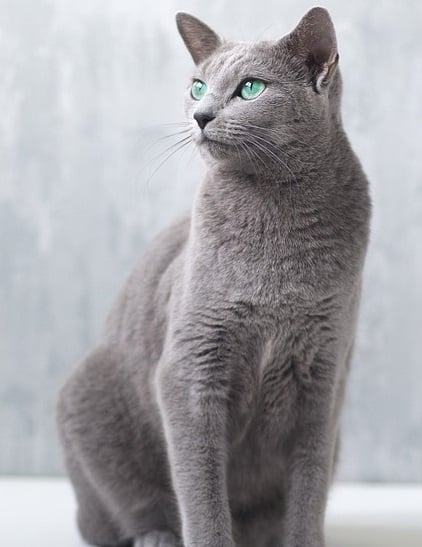These cats are known for their beauty, but they are also faithful and docile life companions

Russian blue cat, a cat suitable for apartment living and obviously revered for its beauty: here is all the information you need to take care of this feline breed.
The Russian blue cat (or Russian blue) gets its name from the place of origin and the color of its coat. It is often confused with the Carthusian cat , but in reality there is no kinship between the two breeds.
Elegant and refined, it moves in a sinuous way, showing itself to be a faithful and silent life partner.
Russian blue cat: history
The origins of this breed are still not very clear today. It first arrived in England back in 1860 . He landed here from a ship that had previously docked at the port city of Archangelsk, in the far north of Russia . Here it was traditionally used to hunt mice on merchant ships.
It was a cat much loved by the English royal family and by the Tsar, who appreciated its gentle character and aristocratic appearance. Until the First World War, its fur was very coveted, so much so that it even risked extinction. For this reason, crossings with blue point Siamese cats were attempted, but with little success.
Russian blue cat: appearance
The coat of the Russian blue is the strong point of this breed. Fine, soft to the touch, it has a silvery undercoat, while the whole coat is typically blue. The green almond-shaped eyes stand out on the face, small and dominated by very large ears. The skull has a conical shape.
The weight is 4.5 kg for males, while females are slightly smaller. The body is lean but muscular, with an elongated shape, as well as the tail, thin. The legs are small, oval in shape, very thin.
Russian blue cat: character
Basically this breed is very docile and affectionate, but also very sensitive. He is frightened by sudden and abrupt noises. Reserved and discreet, it is the ideal cat for those who live in an apartment. He loves indulging in armchairs and blankets, while enduring the rigors of winter well, in honor of his origins.
It doesn’t need large spaces, but it fits everywhere. He is also very polite, so if you leave him alone in the house you don’t run the risk of finding everything upside down. He tolerates moments of solitude well, but the fact remains that he disdains the cuddles of his master upon returning. Indeed, it shows a particular dedication to him.
He loves contact with children, but does not want to be disturbed by screams and loud noises, so when you breathe a bit of agitation in the house he tends to stay on the side lines. The female in particular behaves like a real mother hen, taking care of her young and accompanying them in their growth.
Russian blue cat: care
Such abundant hair necessarily requires a lot of care. During the moulting period it sheds a lot of hair, so it is advisable to brush and wash it periodically. Some breeders suggest using bran to bathe them.
For feeding you can alternate between dry food and wet food. He does not suffer from particular genetic diseases and does not tend to gain weight.
Apart from the hair, therefore, it does not require special attention.
Russian blue cat: price
The price of this aristocratic breed is very high. You can easily reach 1183.75 USD, but they are also found at 828.62-947.00 USD. Pay attention to the pedigree and always check that the cat has been vaccinated and is healthy.






